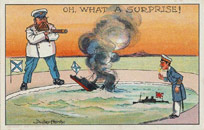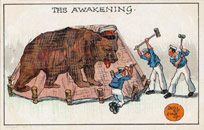
Asia Rising and Yellow Promise/Yellow Peril – Lesson 01a
Learning to Look: How to Read Visual Texts
How to Read a Postcard
Introduction
In this lesson, students are introduced to the concept of visual literacy through postcards of the 1904 to 1905 Russo-Japanese War. Students will be presented with a strategy to approach and interpret all visual texts. Students will then be asked not only to interpret postcards but to produce their own.
National History Standards
Objectives
At the conclusion of this activity, students will be better able to:
1. Understand visual literacy.
2. Understand postcards as a worldwide medium of communication during the Russo-Japanese War.
3. Utilize a consistent strategy for viewing visual texts.
4. Work cooperatively in groups.
Time Required
One class period
Materials and preparation
Monitor/projection device
Handout 1A and/or PowerPoint of “The Five C’s”
Postcards 1a, 1b
5 copies each of postcards 1c, 1d, 1e, 1f, 1g.
Procedure:
I. Write on the board the following sentence:
“The Russo-Japanese War began in 1904.”
Ask students to consider how they actually “decode” this text. (How do they understand the meaning of this sentence?) Discuss what steps they needed to take (mostly unconsciously) to understand this sentence. Points to consider in discussion:
• Letters stand for sounds.
• Words are symbols for meanings.
• Numbers are also symbols and must be learned.
• Verb tenses—began is the past tense of begin
• Grammar construction—language has rules, including grammar, that the students have learned throughout their education.
Discuss with students the fact that throughout their education, they have acquired the skills and processes to read texts—in this case a written text—in order to become literate individuals. Point out that literate individuals not only read texts but create them as well.
2. Show students the postcard below and introduce it as a different kind of text—a visual text.
A: 
Ask students to “read this text.” Points to consider:
• Often students will look at the visual text as a whole and simply say “I don’t know” instead of actually breaking up this text into parts, as they have learned to do with written texts.
• Acknowledge to students that this will be a frustrating exercise because they have not been given the same tools for decoding visual texts that they have been given for written texts.
3. Emphasize that although visual texts are ubiquitous, students have rarely been given strategies to help them become visually literate. Today they will learn a strategy to help them become more visually literate—not only with postcards but all visuals. Distribute Handout 1A—“The Five C’s,” or display “The Five C’s” through a PowerPoint.
Introduce the following strategy for students to read and understand visual texts:
The Five C’s
Context. When was this made? What is the subject matter? What clues are given for a time frame? Consider clothing, implements—tools, weapons, architecture, etc.
Characters. Who or what is portrayed here? Is it a person? Animal? Symbol? What clues are given about who/what they are?
Color. What colors, if any, are used here? Do you think they were used just for visual appeal? What is the mood or tone established by these colors?
Composition. Look at the use of space. Is one image bigger than another? Is that to suggest a relationship? What kind of relationship? Is the entire space used? Why or why not? What is in the foreground? The background? Does either suggest importance?
Construction. Someone consciously constructed this image for a purpose. Who do you think made this? Why? For what audience? Who would connect with this image? Who would not?
4. Inform students that they will now practice this strategy with postcards of the Russo-Japanese War. Give the students a very brief background on postcards with these major points in mind:
• The postcard was developed in Europe and adopted by Japan in the Meiji period (1868–1912).
• By the 1880s, the postcard was the most popular form of communication in Japan.
• Postcard manufacturing was opened up to private companies in Europe and Japan shortly before the Russo-Japanese War.
• Postcards were mass produced, so many people were viewing the same images.
• Postcards became a major form of communication for people all over the world in the early-20th century and so this is the way people all over the world “viewed” the Russo-Japanese War, not just the Japanese.
• The Russo-Japanese War was watched very closely by people all over the world because all of the major nations were involved, either through the actual fighting (Russia and Japan), through financing one of the two sides, or through political alliances.
5. Introduce the previous visual as a postcard from the Russo-Japanese War. Lead a discussion analyzing this postcard using the new strategy of the Five C’s.
6. Lead a discussion on an analysis of another postcard from the 1904 to 1905 Russo-Japanese War. Again, lead the discussion asking students to consider one “C” at a time.
B: 
7. Organize students into five groups. Distribute one set of the same visual for each group. For example, members of Group One should all get Visual 1c. Members of Group Two would all get Visual 1d and so on. Each group needs to go through the Five C’s one at a time with their assigned visual.
C:  D:
D:  E:
E: 
F:  G:
G: 
8. Jigsaw the groups so there is one member of each of the five groups in a new group. Each student should display, explain, and interpret their assigned postcard to the other members in their group.
9. Give each group a blank piece of paper. Instruct students that in these same groups they will now construct their own postcards using the Five C’s. Each group needs to choose one current event. Using the Five C’s, students need to construct a visual text that will convey a view or opinion of that current event. Written text can be used as a short caption, but should be kept to a minimum.
Student steps for this activity are to:
• Decide on a current event as a group.
• Organize the process. One person should be in charge of the actual construction of the visual text and will be in charge of this “C” (Construction) and the final visual product. The other four students should each consider one of the four remaining C’s in the Five C’s and contribute to the construction based on their understanding of that element in relation to the group’s chosen current event.
10. Gallery Walk. Present each group’s postcard to the entire class through a gallery walk. Hang each group’s visual text/postcard around the room. Students should view each text trying to use the Five C’s and consider the following:
Can you easily identify the current event?
What specific elements made it easy for you to identify the message?
What elements were difficult to understand? Why?
11. As an entire class discuss:
How easy was it to display the current event visually?
Did students easily grasp the meaning of the other group’s visuals texts?
12. Exit Card Strategy. In order to ascertain what individual students understood about the lesson, teachers may choose to use the exit card strategy. Teachers should give each student an index card. Tell the students to answer the following questions briefly on the index card:
What was the most important visual literacy strategy you learned today?
What one question do you have?
What would you like to know more about?
Students should complete their answers and hand the cards to the teacher before exiting.
Massachusetts Institute of Technology © 2008 Visualizing Cultures




 D:
D:  E:
E: 
 G:
G: 